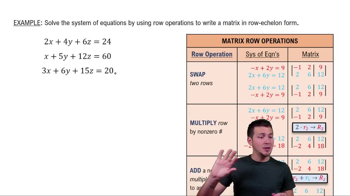Table of contents
- 0. Review of Algebra4h 16m
- 1. Equations & Inequalities3h 18m
- 2. Graphs of Equations43m
- 3. Functions2h 17m
- 4. Polynomial Functions1h 44m
- 5. Rational Functions1h 23m
- 6. Exponential & Logarithmic Functions2h 28m
- 7. Systems of Equations & Matrices4h 6m
- 8. Conic Sections2h 23m
- 9. Sequences, Series, & Induction1h 19m
- 10. Combinatorics & Probability1h 45m
7. Systems of Equations & Matrices
Introduction to Matrices
Problem 109
Textbook Question
Solve each problem. See Examples 5 and 9. Solve the system of equations (4), (5), and (6) from Example 9. 25x + 40y + 20z = 2200 (4) 4x + 2y + 3z = 280 (5) 3x + 2y + z = 180 (6)
 Verified step by step guidance
Verified step by step guidance1
Step 1: Start by choosing two equations to eliminate one variable. Let's choose equations (4) and (5) to eliminate variable 'x'. Multiply equation (4) by 4 and equation (5) by 25, then subtract equation (5) from equation (4).
Step 2: Now, you have a new system of equations with two variables (y and z). Repeat the process with this new equation and equation (6) to eliminate another variable. Let's eliminate 'y' this time.
Step 3: Now, you should have an equation with only one variable left (z). Solve this equation to find the value of 'z'.
Step 4: Substitute the value of 'z' back into one of the original equations to find the value of another variable. Let's substitute 'z' into equation (6) to find 'y'.
Step 5: Finally, substitute the values of 'y' and 'z' back into one of the original equations to find the value of 'x'. Let's substitute 'y' and 'z' into equation (4) to find 'x'.
Recommended similar problem, with video answer:
 Verified Solution
Verified SolutionThis video solution was recommended by our tutors as helpful for the problem above
Video duration:
7mPlay a video:
Was this helpful?
Key Concepts
Here are the essential concepts you must grasp in order to answer the question correctly.
Systems of Equations
A system of equations is a set of two or more equations with the same variables. The solution to the system is the set of values that satisfy all equations simultaneously. Methods to solve these systems include substitution, elimination, and matrix operations, which help find the values of the variables that make all equations true.
Recommended video:
Guided course

Introduction to Systems of Linear Equations
Elimination Method
The elimination method involves manipulating the equations to eliminate one variable, making it easier to solve for the others. This is typically done by adding or subtracting equations to cancel out a variable, allowing for a simpler equation to be formed. Once one variable is found, it can be substituted back into the other equations to find the remaining variables.
Recommended video:
Guided course

How to Multiply Equations in Elimination Method
Substitution Method
The substitution method involves solving one of the equations for one variable and then substituting that expression into the other equations. This reduces the number of equations and variables, making it easier to solve the system step by step. It is particularly useful when one equation is easily solvable for a single variable.
Recommended video:

Choosing a Method to Solve Quadratics

 4:35m
4:35mWatch next
Master Introduction to Matrices with a bite sized video explanation from Patrick Ford
Start learningRelated Videos
Related Practice











